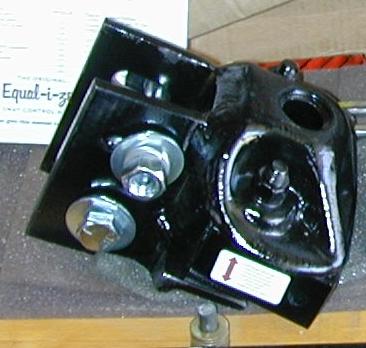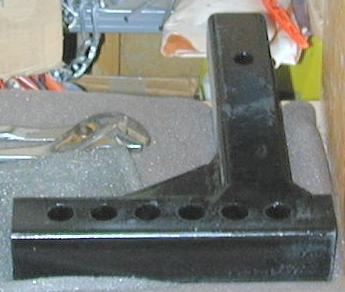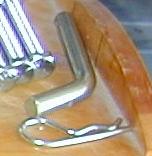Recreation with vehicles in the Sierra Nevada and American Great
Basin areas
Hitch Parts
The connection between your tow vehicle and your trailer serves a
number of purposes. The primary one is to provide a solid mechanical
connection between the two. Another purpose is safety in case of
failure or other problem. A third purpose is to provide control of
motions, both up and down as well as side to side, at the hitch
point.
All parts of the hitch
must be properly rated for their intended use. There are
significant forces involved and the materials and structural design
of each and every part must be sufficient to handle all expected
contingencies.
Receivers
The receiver
hitch is the part that bolts to the frame of the tow vehicle. It
ends in a square tube. The ball mount slides into this tube. Both the
receiver and the ball mount have a hole that allows a pin to slide
through and hold them in place. The receiver is not only designed to
hold the trailer hitch off the ground, it is also designed to
transfer weight from the hitch forward towards the front wheels. This
weight transfer is done by other hitch parts that twist the receiver
to pick the rear end of the tow vehicle and push down on the front
end. This twist or torque is why the
receiver has to be very strong and well connected to the vehicle
frame.
Note that receivers will have different ratings depending upon
whether they are used with or without a load leveling hitch. When a
hitch with spring bars and an appropriate ball mount applies torque,
all of the receiver mounting bolts share the hitch load so it can
handle a larger load. If the trailer tongue is just dropped on the
ball without load leveling apparatus, then the rear bolts on the
receiver have all of the tongue weight pushing down while the front
bolts have it pushing up so the receiver can't handle as much as it
could with a load leveling system.
Ball Mount

The
ball mount can be simply a mount for a trailer ball on the square
pipe that fits into the receiver or it can be a much more complex
mounting point that has connections for spring bars, anti sway
dampers, or special pivot point geometry devices (e.g. the Hensley
hitch). This is usually the heaviest hitch component and may way up
to a hundred pounds. The ball mount shown here is for the Equal-i-zer
hitch. Note that slot for the top bolt that allows adjusting the ball
angle. The washers on a bolt at the bottom of the picture are used to
adjust this angle. The ball is bolted through the hole at the top top
right of the ball mount in the picture.
Shank

The
shank slips into the receiver and provides a mounting point for the
ball mount assembly. The photo shows an adjustable shank that allows
the ball mount assembly to be moved up or down by using different
sets of holes in its vertical part. The leg with only one hole is the
one that slides into the receiver. The hole is to accommodate the
hitch pin that keeps if from sliding out after it has been installed
in the receiver.
Hitch Pin and Clip

The
hitch pin goes through holes in the receiver and shank to keep them
together and is secured with a clip to keep it from falling out.
Balls
The trailer ball is the tow vehicle part of the ball and socket
system that couples the trailer to the tow vehicle in a manner that
allows a lot of both vertical and horizontal movement. The main
trailer ball may also have a smaller ball at the side to allow
connecting a sway control device.
Couplers
The coupler is the trailer part of the ball and socket system. It
sits down over the trailer ball and has a latch to keep it seated.
Chains
Are a backup system whose purpose is to keep the trailer coupler
off the road in the event of a failure of the hitch. Chains should be
loose enough to allow the hitch to operate normally but short enough
to keep the hitch parts off the road in case the ball breaks or comes
loose or there is some other catastrophic hitch failure.
Electrical Connectors
There is an electrical umbilical cord between the trailer and the
tow vehicle. It provides circuits for running lights, brake lights,
and turn signals as well as brake control and battery charging.
Breakaway Switch and cable
The breakaway switch is an emergency trailer brake activation
switch. The pin on the switch is connected to a cable that is
attached to the tow vehicle. The idea is that if the trailer breaks
loose, the breakaway switch will activate so that the whole rig will
be brought to a safe stop. There is some controversy about when this
should be configured to activate. Should it be short enough so that
it will apply the brakes if the safety chains are called into play or
should it be longer so it only applies emergency braking if the
trailer totally disconnects from the tow vehicle?
Spring Bars
Spring bars are steel bars that attach to the hitch ball assembly
and run alongside (usually just below) the A Frame and are then
attached to the A Frame near the trailer wall with chains or
brackets. At the hitch ball assembly the spring bars need to be able
to rotate back and forth but not up and down.
A Frame
The front frame members of the trailer that connect the frame
rails of the trailer to the coupler are called an A Frame. Propane
tanks are usually set in a bracket attached to this A Frame and a
hitch jack is mounted towards the front where the frame comes
together at the coupler.
Sway damping
There are a number of mechanisms that are used to dampen the
trailer's impact on the behavior of the tow vehicle. See
Understanding Sway and Sway
Control for more about this topic. The most common method is a
brake bar mounted between the A-Frame and a small ball a couple of
inches to the side of the main trailer ball. This brake bar has an
adjustment for the amount of friction is applies resisting the
rotation of the trailer about the hitch.
Hitch Setup
See the page on hitch setup to
learn about how these parts and pieces fit together to keep your
trailer and tow vehicle connected for a comfortable and save journey.
Additional Resources
Shopping - USA
Trailer hitches -|- Trailer
Hitch Balls By Reese -|- Hitches,
Tow Bars/Dollys & BrakeBuddy -|- HitchItch
-|- Trailer
hitch bike rack and trailer hitch accessories - etrailer.com
U.S.
Department of Transportation - National Highway Traffic Safety
Administration (NHTSA) - Towing A Trailer, Being Equipped for
Safety - Title Page and Table of Contents - DOT HS


TechComm
Labs (tm)
|
|

supporting
and using open software
|
Disclaimer:: any advice or suggestion presented
is provided for informational purposes only and is correct and
accurate only to the best of our knowledge at the time it was
written. Anyone using such information does so at their own risk.
Errors or omissions may exist and additional sources of information
or appropriately licensed or qualified personnel should be consulted
in deciding a course of action. We assume no liability or obligation
by providing this information and warn any users of this information
that they do so at their own risk. All links or references to
commercial vendors or other sources of information and equipment do
not intend or imply or convey any endorsement of that source or the
product. They are provided strictly for informational purposes to
illustrate the topic at hand. Sierra
Nevada Airstreams Enjoyment of the whispering winds, the
zephyrs, the airstreams of the Sierra Nevada and Great Basin areas of
the United States is a personal, nonprofit, noncommercial web
site intended for educational and recreational use only. This site is
supported by volunteer effort and contributions. Donations
accepted thanks to the Amazon.com


